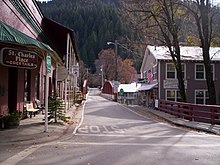Jersey Bridge (Downieville, California)
Jersey Bridge | |
 Jersey Bridge in 2024 | |
| Location | Commercial Street, Downieville, California, U.S. |
|---|---|
| Coordinates | 39°33′36″N 120°49′40″W / 39.56000°N 120.82778°W |
| Area | 0.1 acres (0.040 ha) |
| Built | 1938 |
| Built by | Judson Pacific Company |
| Architect | George F. Taylor |
| Architectural style | through Pratt truss bridge |
| MPS | Highway Bridges of California MPS |
| NRHP reference No. | 12000401[1] |
| Added to NRHP | July 10, 2012 |
The Jersey Bridge is a truss bridge that carries traffic connecting Main and Commercial Streets over the Downie River in Downieville, California. Constructed in 1938, it is a rare surviving example of a one-lane, steel, rigid-connected polygonal Parker through Pratt truss span. On July 10, 2012, the bridge was listed on the National Register of Historic Places, recognizing its historical and architectural significance. The bridge is also known as the Highway 49 Bridge, or Downie River Bridge and continues to carry California State Route 49.
History
[edit]

The Jersey Bridge is one of four one-lane bridges that connect the town of Downieville, California. It was built in 1938 by the Judson Pacific Company to replace a bridge destroyed by a flood. It was designed by county surveyor and architect George F. Taylor.[2][3]
The Durgan Bridge is also historically significant as the site of the lynching of a Spanish woman known as Josefa Segovia, also known as Juanita, on July 5, 1851, the only recorded lynching of a woman in California’s history.[4][5]
Design
[edit]The Jersey Bridge was designed to carry both automotive and pedestrian traffic connecting Main and Commercial Streets over the Downie River. The single-lane bridge is 12.5 ft (3.8 m) wide and 120 feet (37 m)-long. Constructed in a steel Pratt through truss bridge, it features riveted steel I-beams and runs north-south along Commercial Street. At each end of the bridge, a builder’s plate that reads, “Judson Pacific Co., San Francisco, 1938.” The bridge's roadway deck is constructed from poured concrete, while the pedestrian walkway is made of wooden boards supported by steel I-beams, with steel posts and wooden handrails on both sides. The north end of the bridge rests on a concrete abutment, and the south end is supported by a pier made of board-formed concrete, featuring two concrete cylinders encased in riveted steel.[2] The St. Charles Hotel once stood across the street at the end of the bridge but was destroyed by fire in 1947.[6]
The Jersey Bridge was named for its role in connecting the downtown area with Jersey Flat. Over the years, it faced multiple disasters: it was destroyed by flood in 1852, fire in 1858, [7] damaged by flood again in 1861, collapsed under weight in 1876, and was once more destroyed by flood in 1937, which also wiped out the nearby Durgan Bridge. The current Jersey Bridge, built in 1938, has since carried California State Route 49 on its one-lane roadway.
Historical significance
[edit]Only a small number of single-lane Pratt through truss bridges still survive in California today. The Jersey Bridge is associated with the community planning and development of Downieville in Sierra County, built in response to a 1937 flood that destroyed the previous wooden bridge. It stands as a good example of the Truss Bridge type. It serves as the main highway through Downieville. [2]
The bridge is linked to the California gold rush, as it is referenced as a key location where gold was extracted. In 1850, a young boy arrived in Downieville and found work at the Jersey claim, which was located where the Jersey Bridge now stands. At the time, it was the richest mine along the river, and the boy struck gold.[8]
See also
[edit]- Jersey Bridge
- Hospital Bridge
- National Register of Historic Places listings in Sierra County, California
Further reading
[edit]- “The Great Flood of 1937, Downieville, California,” by Virginia Lutes
- James J. Sinnott (1972). Downieville, Gold Town on the Yuba. California Traveler.
- James J. Sinnott (1973). History of Sierra County, A General history of Sierra County. California Traveler.
- National Geographic's Guide to Small Town Escapes. National Geographic. 2000. ISBN 978-0-7922-7604-3.
References
[edit]- ^ "National Register Information System". National Register of Historic Places. National Park Service. November 2, 2013.
- ^ a b c Adams, Lee (May 25, 2012). "Jersey Bridge - National Register of Historic Places Registration Form". National Park Service. Retrieved October 17, 2024.
- ^ "SHRC REGISTRATION ACTION- January 20, 2012". California State Parks. Retrieved October 17, 2024.
- ^ Five Views: An Ethnic Historic Site Survey for California. California Office of Historic Preservation. Retrieved October 7, 2024.
- ^ Segrave, Kerry (July 8, 2010). Lynchings of Women in the United States The Recorded Cases, 1851-1946. McFarland, Incorporated, Publishers. pp. 21–22. ISBN 9780786460083. Retrieved October 25, 2024.
- ^ "Fire Destroys Famous Hotel". Portola Reporter. Portola, California. July 31, 1947. p. 1. Retrieved October 18, 2024.
- ^ "Sierra County". The Daily California Express. Marysville, California. March 9, 1858. p. 2. Retrieved October 18, 2024.
- ^ "Those Yellow Stones". Sierra County Tribune. Forest City, California. April 19, 1883. p. 3. Retrieved October 18, 2024.
External links
[edit]- Jersey Bridge--Downieville, CA
- Downieville Forks
- Historic Sites and Points of Interest in Sierra County
![]() Media related to Jersey Bridge, Downieville, California at Wikimedia Commons
Media related to Jersey Bridge, Downieville, California at Wikimedia Commons



